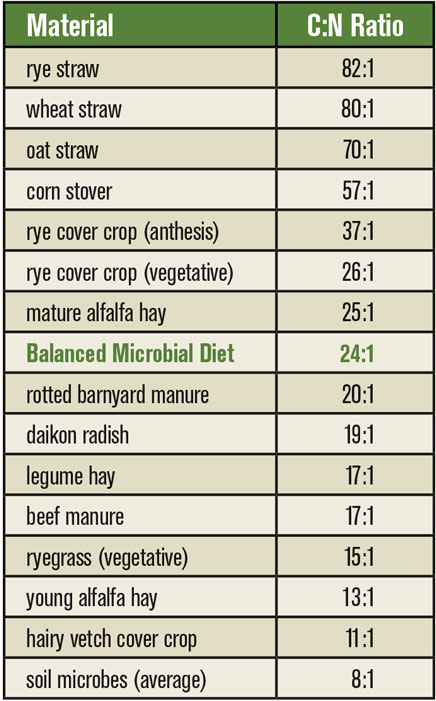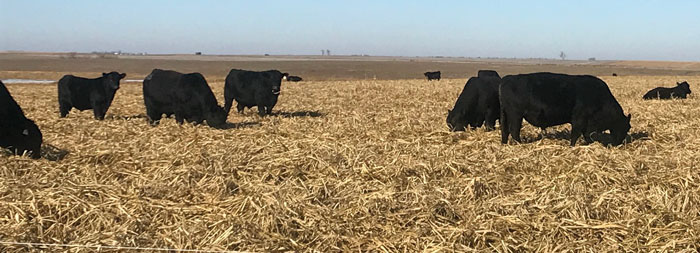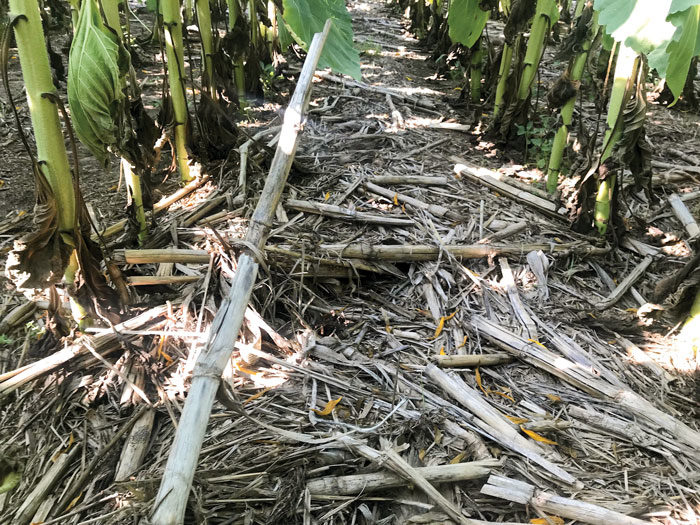With every decision Dan Forgey makes about the farm he manages in central South Dakota, one thing is top of mind.
“All I’m trying to do is promote soil health,” he says. Forgey is the agronomy manager for Cronin Farms in Gettysburg, S.D., a 10,500-acre no-till farm owned by Monty and Mike Cronin.
Forgey says soil in good health is resilient and able to maintain enough moisture to withstand drought conditions.
“Soil health is difficult to build, hard to maintain and easy to destroy,” he says.
While Forgey regrets the years he spent unintentionally damaging the soil he farmed, he’s grateful to have learned better ways to support soil conservation and health.
“We didn’t understand anything about the concept of soil health” in the 1970s and 1980s, Forgey says. He remembers working the soil 14 times over the course of 4 years and harvesting 3 different crops in that same time period.
“The sad thing was we considered ourselves good farmers at that time,” Forgey says. “I learned how to destroy our soil organic matter. No one was there to tell us we were doing that. It’s sad. There are a lot of people it’s still happening to, so I take what I’m doing to heart if I can help someone in their journey.
“I want to help the younger generation succeed.”
Diverse Crop Rotations are Key
One strategy Forgey has found to be especially helpful in boosting soil health is diversifying his crops.
“We need diversity,” he says. “We try to mimic nature with cool and warm season grasses and broadleaf plants. We focus on being proactive and preventing problems from happening, rather than constantly reacting to problems that occur. That’s what we’re trying to do with rotations and cover crops.”
When Forgey switched to no-till in 1993, he was following a rotation that included two kinds of wheat, corn and sunflowers.
“Sunflowers on corn is just second nature out here,” he says.
But as good as Forgey felt about the setup of that rotation, it was clear it wouldn’t work forever.
“Anytime you stay in a rotation, it doesn’t take long for the insects or the grasses and weeds to figure you out,” he says. “You’ve got to trick them.”

SELECTING COVERS. Cover crops should be selected based on what their intended function is, says Forgey. Different covers have different carbon-to-nitrogen (C:N) ratios and if you’re looking to build soil organic matter, he says covers with higher ratios will be better bets.
Now Forgey uses a John Deere 1895 drill in a no-till rotation that includes cereal grains, field peas and lentils in April, sorghum and sudangrass in June, cover crops in July and August and winter wheat in September. He applies 90% of the fertilizer he uses at seeding. Additionally, Forgey relies on a 24-row planter to no-till corn and soybeans in May and sunflowers in June.
“Planting and harvesting timing is key,” he says. “We don’t jam everything into the fall. We’ve got all season to get stuff done.”
When planning out their crop rotation strategies, Forgey and his colleagues looked for ways to maintain as many high carbon crops as possible while ensuring a minimum of 70% high residue crops. Relying on major crops such as winter and spring wheat, oats, corn, soybeans, sunflowers and alfalfa has helped them maintain a balance of 73% high residue crops and 27% low residue crops, which Forgey says is ideal.
“By doing this we started putting carbon into the system,” he says. “We started increasing organic matter and gaining soil health. I just can’t emphasize what a difference it makes.”
Benefits of Organic Matter
Because organic matter contains such a high percentage of carbon (57%), increasing the organic matter in the soil has a direct impact on the health of the soil, Forgey says.
“The more you can focus on organic matter and what its purpose is, the better off you’re going to be,” he says.
Not only does organic matter benefit the soil by releasing carbon, but it also supplies nutrients such as nitrogen (N), phosphorous (P) and sulfur (S), Forgey says.
He advises farmers who are trying to increase their organic matter to consider ways to reduce or eliminate tilling, as well as strategies for erosion reduction. He also emphasizes the importance of proper fertilization.
“You don’t want to over fertilize — that’s really a downfall,” Forgey says. “Anytime we put too much fertilizer on, our yield drops some. We’re not letting the soil work for us.
“It’s like burning your house for heat — you did get some heat, but you destroyed your house…”
“I’m not saying go cold turkey and quit all fertilizer. But one of the reasons some farmers see their pH dropping is because they’re over fertilizing.”
Forgey does regular soil sampling and variable rate application of fertilizer, which he says has been a big help with proper management of nutrients.
Maintaining Moisture
Something else Forgey relies on for building and maintaining soil health is moisture conservation, which he accomplishes through appropriate soil coverage.
“When you look at your soil, you should be looking through residue,” he says. “A good mulch can reduce evaporation by 4 inches of moisture per year. We keep our ground covered to keep all that moisture for the crop.”
Forgey says when the soil temperature is under 70 degrees F, 100% of the moisture in the soil is used for crop growth. This can be achieved with good residue cover. He’s noticed that the soil temperature is significantly lower in fields that are properly mulched. Those fields with a lower soil temperature are better at utilizing the moisture present in the soil, which has a positive impact on crop growth.
“That’s terribly important, even if we’re in a period of high rainfall, because that rainfall might not last all summer.”
Livestock Nutrient Cycling
Integrating livestock has been a tremendous help for Forgey as he works to continually boost soil health. Although he’s been fortunate to manage a farm with its own cattle (Cronin Farms has an 850-head cow/calf herd on 8,500 acres of grass on the Missouri River Breaks), Forgey says farmers without livestock can consider having cattle brought in. Regardless of whether the livestock is owned or borrowed, though, he says one thing is key.

NUTRIENT CYCLE. Grazing cover crops is a strategy Forgey recommends to cycle nutrients more quickly. One mixture he utilizes is 40% forage sorghum, 30% pearl millet and 30% piper sudangrass.
“You have to have a plan,” Forgey says. “You can’t just turn them loose.”
Utilizing cattle to graze cover crops in fall and winter yields several benefits, Forgey says. Not only does it increase the livestock’s food quantity and quality at a time of year when pasture forage value can be low, but it also increases the biological activity in the soil, which improves nutrient cycling.
Ultimately, if managed appropriately, this has a positive impact on soil health.
“When you graze cover crops, you do not lose residue,” Forgey says. “You just cycle it faster. When they eat, the cow is going to keep 20%, and 80% is going to go out the back end in either urine or manure.
“Basically, if you want to cycle your nutrients, cattle is how to get it done.”
In addition to yielding health benefits for the cattle and soil, grazing cover crops is a great strategy for cost saving, Forgey says. In comparison to the daily cost of relying on a feed wagon for cattle, it’s cheaper to rely on cover crops to feed livestock, although the specific savings amount is dependent on how much a no-tiller is spending on their cover crop mix.
Forgey says farmers who rely on grazing should be sure to take biomass samples to test soil composition.
“Test a square yard in two or three places, send it in to a lab and find out what you’ve got,” he says. “That way you know how much carbon and nitrogen you’ve got, how much you can feed and how many days you can feed it.”
Small Steps
Although it took Forgey close to a decade to start to reap the significant benefits of increased carbon derived from switching to no-till, he encourages farmers to consider giving it a try.
“No-till captures carbon and organic matter, which is full of nutrients,” Forgey says. “Yes, the tillage pass will release those nutrients and cause the crop response, but then you’re back to square one.
“It’s like burning your house for heat — you did get some heat, but you destroyed your house.”
Relying on no-till has helped Forgey limit soil disturbance, which in turn supports increased soil aggregates, pore spaces, soil biology and organic matter. Not only that, it reduces the amount of diesel fuel used on the farm.
“We’re really helping the environment,” Forgey says.
He cautions farmers to remember that changes he’s made to improve the health of his soil didn’t happen overnight — and that building soil health isn’t the only thing that matters for someone who’s farming a cash crop.
“No matter what you’re doing for soil health, you have to show that you are making money,” Forgey says. “I don’t think you want to do it all at 100% — try stuff on a small scale. If you’re not doing any of these practices, don’t think you’re going to be a failure.
“Just start doing something.”







Post a comment
Report Abusive Comment